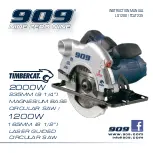
l) Keep cutting tools sharp and clean. Properly maintained cutting tools with sharp cutting edges
are less likely to bind and are easier to control.
n) Use the power tool, accessories and tool bits etc. in accordance with these instructions, taking
into account the working conditions and the work to be performed. Use of the power tool for
operations different from those intended could result in a hazardous situation.
Have your power tool serviced by a qualified repair person using only identical replacement parts.
This will ensure that the safety of the power tool is maintained.
SERVICE
USE AND HANDLING OF THE CORDLESS
ELECTRICAL POWER TOOL
a) Charge a rechargeable battery unit using only the charger recommended by the manufacturer.
Chargers are often designed for a particular type of rechargeable battery unit. There is the danger
of fire if other types of rechargeable battery units are used.
b) Only the rechargeable battery units supplied are to be used with an electrical power tool. The
use of other rechargeable battery units may lead to the danger of injury or fire.
c) When they are not being used, store rechargeable
battery units away from paperclips, coins, keys, nails, screws or other small metal objects that
could cause the contacts to be bridged. Short-circuiting the contacts of a rechargeable battery
unit may result in heat damage or fire.
d) Fluids may leak out of rechargeable battery units if they are misused. If this happens, avoid
contact with the fluid. If contact occurs, flush the affected area with water. Seek additional medical
help if any of the fluid gets into your eyes. Escaping battery fluid may cause skin irritation or burns.
a) Ensure that the device is switched off before inserting the battery. Inserting a battery into a
power tool that is switched on may result in accidents.
b) Recharge the batteries indoors only because the battery charger is designed for indoor use
only.
c) To reduce the electric shock hazard, unplug the battery charger from the mains before cleaning
the charger.
d) Do not subject the battery to strong sunlight over long periods and do not leave it on a heater.
Heat damages the battery and there is a risk of explosion.
e) Allow a hot battery to cool before charging.
f) Do not open up the battery and avoid mechanical damage to the battery. Risk of short circuit
and fumes may be emitted that irritate the respiratory tract. Ensure fresh air and seek medical
assistance in the event of discomfort.
g) Do not use non-rechargeable batteries!
SPECIAL SAFETY DIRECTIONS FOR BATTERY-OPERATED TOOLS
a) This device can be used by children aged 8 and over and by people with reduced physical,
sensory or mental capacities or with a lack of experience or knowledge, if they are supervised or
have been instructed regarding safe use of the device and understand the resulting risks. Children
are not permitted to play with the device. Cleaning and user maintenance are not to be undertaken
by children without supervision.
b) Children should be supervised to ensure that they do not play with the appliance.
c) To charge the battery, use only the charger supplied. Risk of fire and explosion. This ensures
that the safety of the device is maintained.
d) Before each use, check the charger, cable and plug and have them repaired by qualified
professionals and only with original parts. Do not use a defective charger and do not open it up
yourself. This ensures that the safety of the device is maintained.
CORRECT HANDLING OF THE BATTERY CHARGER
5
6


























